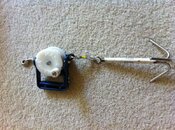This is easy... your personal dive float should not have an alpha flag as YOU are not a vessel. However, any boat qualifies as a vessel and can fly the alpha flag. In Florida, flying JUST a divers down flag could earn you a citation. That's an FWC rule. Diving operations in the State of Florida, whether they are commercial or private must display a Divers Down flag. They can display any other flags which are appropriate, but they are breaking the law if they don't have a Divers Down flag. I hope that helps you out.
I think then that there is simply a difference between California and Florida law, which is no surprise, I personally would expect Florida to have more diver-conscious laws. However the fact remains that 1) PADI teaches the Alpha pennant to be ok for dive floats, not just boats, 2) The USCG allows the Alpha Pennant to be used on dive floats, and 3) that in some states (I.E CA) there is no legal protection if you fly a diver down flag vs if you fly an Alpha Pennant as was my original point (this is also straight from the CG)
Where are these parts of Cali? I know in Nevada it is a law, but have never heard of it in Cali.
I know that here in CA, in all U.S National Recreation Area lakes there is a minimum $250 ticket if you do not dive with a dive float, or if you move too far off away from one. I've even been at a cove in a lake (Whiskeytown Lake) where we had just finished diving as another group pulled in and a ranger showed up. The conversation went as follows:
He asked us "Hey, you guys with those divers out there?"
We responded "Nope, we just finished, whats up?"
He answered: "Well they aren't diving with a dive float. I'll have to wait till they come back up and give them a ticket."
We talked a bit more, the ranger turned out to be a family friend, but we learned that its common practice for rangers here to watch for diver's bubbles in the absence of a float. If they dont see a float, they wait until the divers surface, sometimes following the bubbles, and give them the ticket. It would be interesting to hear if this practice is the same in all National Parks?






